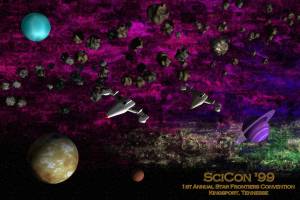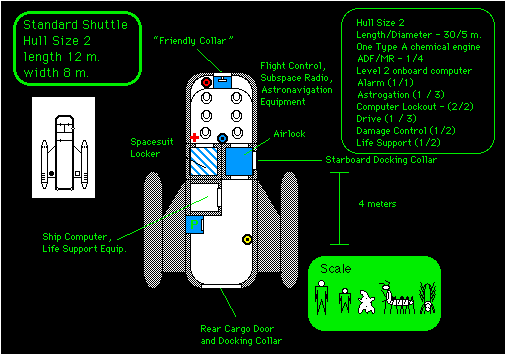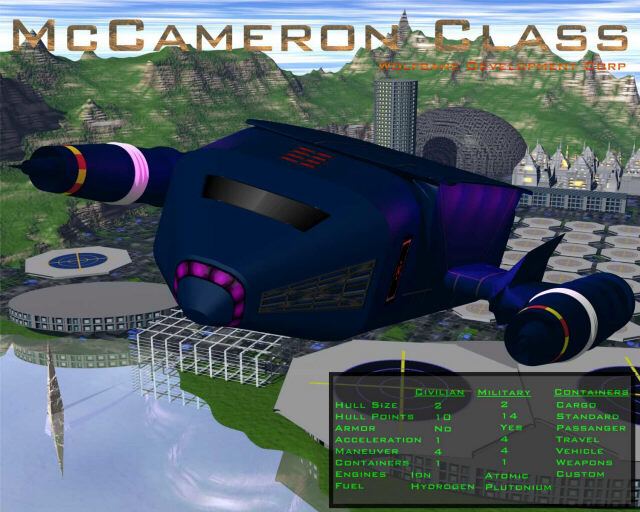compiled by Tom Verreault
|
Editor's Note: These reports are compiled from the Sci Con websites that were once part of the Frontier News Network Site but now are no longer live on the web. They can only be found as part of the Internet Archive at the Sci Con 1 archive and the Sci Con 2 archive. We thought it would be appropriate to preserve a summary here as the cons introduced the last 'canon' material blessed by the creators of Star Frontiers as well as an interview with some of those creators. |
Sci Con I - February 1999
Attended by Andy Campbell (Kveldulf), Dean Bailey (KDBAILEY91), Frank Pentatubo (Sir_phalanx), Albin Johnson (fairhand), Alan Isom (aisom), Roy Romero (roymeo), Matt Crymble (m76762) and Denni Feagins (dfeagins)
The convention began with a meet and greet on Friday night at the Meadowview Convention Center in Kingsport, Tennessee. Participants grabbed dinner where they could and the socializing lasted until 1:00 am.
On Saturday the Convention began in earnest at 9:15 am. Andy Campbell’s Netbook was presented and 30 to 40 minutes are taken up with reviewing the impressive amount of material in it. [Editor's note: The Netbook was an old Star Frontiers website. It is no longer live but can be found on the Internet Archive. I also have a copy of its contents and hope to get them, as well as the con websites, on-line at the Star Frontiers Network Archives at some point.] Around 10 am Albin Johnson began a marathon 12 hour Star Frontiers adventure with brief breaks for food. His adventure included the locations Chinzo Station, the ship the Lady Vane, and Charon Tavis Asteroid.
Sunday involved breakfast at Matt’s parent’s house and signing of the con book and photographs.
The McCameron Class Shuttle
The McCameron Class shuttle was introduced at the convention. It was named after a James McCameron. James was and extraordinary game referee and fan of Star Frontiers. Albin Johnson had maintained a touching tribute to him on his website for many years.Included here are the recovered data files on the McCameron Class Shuttle. At Sci Con 2 (below) one of the original creators of Star Frontiers, Lawrence Schick endorsed the McCameron class shuttle as official game material.
Description
The McCameron Class shuttle is named for the famous adventurer James McCameron who explored and expanded the frontier in innumerable directions.
The McCameron Class shuttle has been a part of the frontier as much as the ideals of freedom and individualism. Predating the birth of the UPF by at least 25 years, the McCameron Class shuttle has been the backbone of the spacefaring culture that is the UPF. The ease of construction and low maintenance of the McCameron Class shuttles have made them available in all parts of the Frontier. The atmosphere handling capabilities allows the shuttles to be built and tested on the ground, which also keeps the cost down. The shuttles are currently built by the Wolfbane Development Corp at any Class A, B or C starport.
The McCameron Class shuttle is the workhorse of the frontier. The standard version (Mk I) is as show, with both cargo and passenger capability. The Mk II has no passenger capability, but can carry twice the cargo. The Mk III is just the opposite in that it has twice the passenger capability with almost no cargo area. The Mk IV is a jumbo shuttle in that it is a cargo carrier, but with more cargo capacity than the Mk II.
Ship Stats
| Civilian | Military | |
|
Hull Size |
2 |
2 |
|
Crew |
2 |
2 |
|
Hull Points |
10 |
14 |
|
Armor |
No |
Yes |
|
Acceleration |
1 |
4 |
|
Maneuver |
4 |
4 |
|
Containers |
1 |
1 |
|
Engines |
Ion |
Atomic |
|
Fuel |
Hydrogen |
Plutonium |
|
Width |
7m |
7m |
|
Length |
17m |
17m |
|
Height |
5m |
5m |
|
Wingspan |
17m |
17m |
|
Model |
Type |
Capacity |
|
Mk I |
Standard |
9 Passengers |
|
Mk II |
Cargo |
420 m3 Cargo |
|
Mk III |
Liner |
18 Passengers |
|
Mk IV |
Jumbo |
840 m3 Cargo |
|
Mk V |
Travel |
6 Passengers |
|
Military Only |
||
|
Mk X |
Weapons |
Laser Piston Battery |
|
Mk XI |
Transport |
30 Troops |
SciCon2 – October 1999
Following on the heels of the successful Sci Con 1 in February, Sci Con 2 was quickly organized and had greater attendance. The new picture of the McCameron Class Shuttle, seen above was the official convention poster. There were door prizes which included a rare copy of Dramune Run and new Alternity material donated by TSR. It was again held at Meadowview Resort in Kingsport Tennessee.
The events at the con included conference call interviews with
Lawrence Schick, one of the original game designers, and with Kim Eastland, the author of Zebulon’s Guide. The games that were hosted at the convention were “Dogs of War” by Stanley Brown, “To Serve and Protect” by Andy Campbell, “Shadows in the Dark” by Layne Saltern, and “But the Tigers Come at Night” by Brad McMillan.
The following are the notes taken from the teleconferenced interviews of the game designers Lawrence Schick and Kim Eastland. Note these are all that is available and if you possess a copy of the audio recordings of these interviews please contact the editorial staff of the Frontier Explorer (editors@frontierexplorer.org) as we would love to make them available to the public through the Frontier Explorer website. The notes are presented as published on the Sci Con site.
Guest Speaker: Lawrence Schick
Interview by Matt Crymble
Lawrence Schick is one of the two original creators of Star Frontiers. With the help of Dave "Zeb" Cook, he created the game we all know and love. I have been in contact with Mr. Schick and he has been kind enough to commit to a "conference call" with us at the convention. This will be a real time question and answer session with Mr. Schick on speakerphone speaking to us.
Here are some of the topics and his response to them:
Races
Yazirians were the embodiment of the ID.
The Sathar were originally to be known as the S'sessu, and they were to be a PC race. (Later this occurred) [Ed. Note: See the interview Tom Verreault did with Dave Cook that was published in the Star Frontiersman Magazine, issue 18]
Schick created the insectoid Vrusk, the ideal of teamwork and cooperation. Vrusk had a hive-like society in which the group came first, and players could play off of that angle; interestingly, the vrusk also were obsessed with aesthetics - ugly objects or living things could literally send them into an "artistic frenzy" in which the vrusk would mindlessly destroy the offending objects/beings.
Schick also created the wormlike S'sessu, a wormlike race best described by Schick himself as the ultimate "amoral libertarians". The S'sessu are the diametrical opposites of the group-oriented vrusk; the worms only cooperated for mutual gain, and treachery among them was common. When Alien Worlds was sent to TSR, it was decided the game needed a black and white background and therefore an enemy - and so it was the amoral S'sessu became the diabolical Sathar.
Dave "Zeb" Cook was responsible for the Yazirians and Dralasites. Like Schick's species, they were exaggerated fragments of the human psyche. The Yazirians were flamboyant and high-strung, given to great emotion. The Dralasites by contrast were the jokesters of SF, with an odd sense of humor as described in the books. Said Schick: "Dralasites are big on shape humor. A dralasite would find a tube very funny." This led to no end of dral jokes among the Con crowd.
Homeworlds
The original idea was to release a module for each of the five major PC races. (In the original game, there were 5, not 4, PC races.) Each module would include background information – including the homeworld – of one of the races. This obviously never happened.
Skills
His original skill system was much simpler than the one that appeared in Alpha Dawn. He found it strange that the TSR editors made the skill system more complex with the move to Alpha Dawn, since overall it was their intention to make the game simpler.
The subskills that appear for the skills in Alpha Dawn were added after the game left Schick's hands.
That there were "A" skills and "B" skills--the "B" ones being more advanced and harder to obtain. Whether this was something like "Basic Medical Skill" vs. "Advanced Medical Skill," or something a bit more diversified, I don't know.
The SF designers started with their concept that mechanics should follow role-playing, and designed around what PC's should be able to do. Streamlined mechanics were emphasized; originally there were just skills, classed A and B. A skills were simpler and cost less to gain; B skills were more complicated and cost more points. There were no subskills - the AD subskills were originally all skills in their own right, more like the way Zebulon's Guide did them (only no color bars). Schick was baffled when TSR complicated the system with subskills with fixed % values instead of a unified skill list with unified skill percentages for success.
Technology
Inertia screens were inspired by shields in Dune.
It's really too bad the gauss weapons were taken out. (We were robbed!)
Tech was drawn from literary science fiction, favoring "hard sci fi". Railguns were in the original game as artillery pieces, but for some reason replaced by Recoilless Rifles in the AD game.
Game Mechanics
SF's original title was "Alien Worlds."
SF was originally to be released in basic and expert sets.
Schick left TSR before the game was published, so he never got to do any more with it after the original version.
If we could just get our hands on those water stained originals in Schick's home, we could say for sure about Alien Worlds
Influences
Schick and Zeb (Dave "Zeb" Cook) were primarily influenced by the literary science fi tradition, more so than the popular science fi which saturated the late 70's / early 80's (i.e. Star Wars, the Trek movies, Alien, Battlestar Galactica, Bladerunner). While the movie stuff was great, the SF designers worked mainly from authors like Larry Niven, Poul Anderson, Frank Herbert, etc.
Design Philosophy
The game was from the start designed around what the team wanted PC's to be able to do, rather than to mirror real tech past or future. Robots and computers were kept intentionally "dumb" so that PC's had to be self-reliant. Since it is much more engaging for a player to "do it themselves" (whether it's taking out a villain, shutting down a reactor, etc.) the tech was played down somewhat in favor of high adventure.
The original game was intended to offer a more thoughtful experience than other science fiction RPG's of the time; hence the original title "Alien Worlds". Each species (as in most sci-fi) represented a fragment of the human psyche, exaggerated.
Schick gave the impression he wanted to design a game for real role-play - let players and GM's explore new worlds, go off on great adventures etc., in the tradition of "classic sci fi" like Niven's Known Space stories, Asimov's Foundation series, Poul Anderson's Ensign Flandry stories, etc.
Life After TSR
Schick ran a SF (Alien Worlds) game well through the late 80's / early 90's among his friends and continued to develop / refine the mechanics. He still has the notes in his basement somewhere. Asked if he'd consider releasing the refined Alien Worlds as a system to an RPG company, he replied that too much of it was borne of SF and would risk legal problems.
After TSR, Schick went into game design and computer programming, working on computer, video and arcade games. He was [at the time of the interview] in charge of AOL's online RPG content, and selects what online games will be run by AOL.
Guest Speaker: Kim Eastland
Interview by Matt Crymble
Kim Eastland, creator of Zebulon's Guide to Frontier Space, spoke to us about Zeb's and answered some important questions. Here are some of the topics and his response to them:
Races
The Osakar were a race created from a miniature made of 2-part epoxy. This miniature has now been donated to Sci Con. Thanks Kim!
As suspected, the Ifshnits were indeed the dwarves of SF.
The Humma were based on a character that was played in Kim's group from a Gamma World campaign. They were intended as a "brick" race.
Ifshnits were related to dwarves in fantasy campaigns. What he failed to mention is where the name originated from. Kim Eastland's gaming group got in the habit of referring to anyone playing a dwarf as 'little sh&t'. This was translated it SF as Ifshnit. So, most posts making fun of the ifshnit's name are not totally off base.
Humma (which he pronounced Hoo-ma) were put in because it would be neat to have a race that could stomp one to death like Kim's mutant kangaroo PC from his Gamma World campaign (kid you not on that one). The Osakar were also originally a GW PC ported to SF as a new species.
Homeworlds
He deliberately left the homeworlds out of Zebulon's Guide volume 1 and had no intention of ever including them in his additional 14 volumes of the Guide that were never completed. His reasoning was that he did not want to conflict with background material along these lines that dozens or possibly hundreds of GMs may have already developed on their own.
The Tetrarchs were a concept so that Refs would have an excuse for similar aliens and creatures to be found on many worlds. They were an ancient race that traveled the Frontier long before there were other sentient races. They deposited about 100 various types of animals on many planets, so that Refs would not have to make up new creatures to fight every weekend. A fine concept if you ask me! (Star Trek also did this)
Technology
The Bap Bins were brought in to allow refs a chance to avoid space travel or orbital hops. They are an optional plot device. They were thrown in because Kim's playtest group was worried about being attacked in space and having nowhere to run away (I kid you not).
Robots were slated for Zeb's II, and the existing material was ported to the Gamma World Module "Epsilon Cyborg."
Vision
Eastland had a very ambitious vision of what he wanted Star Frontiers to become, but that vision was not in harmony with the original game setting. (He flat-out said that he wanted the game to be more like Gamma World.) Eastland hated the Alpha Dawn rules, especially the skill system, and he hated Knight Hawks. One of his future planned projects was to throw out Knight Hawks and start over from scratch his way.
Timeline
He changed the timeline himself, simply because it didn't correspond with what HE wanted to do with his future volumes of Zebulon's Guide.
What is the major problem with the Zeb's timeline? Is it just the feeling that the Frontier would not have been populated and developed as quickly as the line suggested? Actually, that's one of the reason's Kim Eastland gave for changing the timeline. He wanted to do some modules that took place in the Frontier's distant past, and the original timeline didn't have enough of a past to work with.
Artwork
The guy on the cover of Zeb's was Kim's boss at the time.
The corrections to Zeb's that were printed in Dragon said that a caption was dropped from above that picture "Mechanon Propaganda Poster". Kim Eastland, the creator of Zeb's Guide, mentioned this picture at SciCon2. He was... not really pleased with that one. So maybe that's how these comments crept in to the corrections.
Death of Star Frontiers
Linda's father invented Buck Rogers, and she killed Star Frontiers to start a Buck Rogers line at TSR. Her take on this move was that even if TSR lost money, her family would make money through licensing fees. Despite this, Kim said the Buck Rogers game was actually quite excellent, and something to snatch up if you ever found one.




